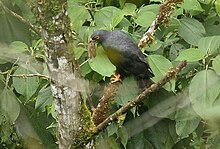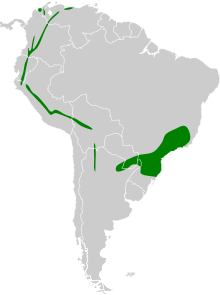| White-rumped hawk | |
|---|---|

| |
| Conservation status | |
 Least Concern (IUCN 3.1) | |
| Scientific classification | |
| Domain: | Eukaryota |
| Kingdom: | Animalia |
| Phylum: | Chordata |
| Class: | Aves |
| Order: | Accipitriformes |
| Family: | Accipitridae |
| Genus: | Parabuteo |
| Species: | P. leucorrhous |
| Binomial name | |
| Parabuteo leucorrhous (Quoy & Gaimard, 1824) | |

| |
| Synonyms | |
|
Buteo leucorrhous | |
The white-rumped hawk (Parabuteo leucorrhous) is a species of bird of prey in subfamily Accipitrinae, the "true" hawks, of family Accipitridae. It is found in Argentina, Bolivia, Brazil, Colombia, Ecuador, Paraguay, Peru, and Venezuela.
Taxonomy and systematics
The white-rumped hawk was previously placed in the large genus Buteo but a 2009 paper provided the evidence to move it to genus Parabuteo, joining Harris's hawk (P. unicinctus) there. An earlier proposal to place it in the resurrected genus Percnohierax was not accepted. The white-rumped hawk is monotypic.
Description
The white-rumped hawk is 33 to 40 cm (13 to 16 in) long with a 67 to 79 cm (26 to 31 in) wingspan. One male weighed 290 g (10 oz) and one female 389 g (14 oz). Males and females have the same plumage. Adults are almost entirely black but with the namesake white rump and undertail coverts. Their tail has a narrow grayish-brown band at its midpoint and their thighs are feathered rufous. Their eye, cere, legs, and feet are yellow. Immatures have brown upperparts with rufous mottling and heavily mottled rufous underparts.
Distribution and habitat
The white-rumped hawk has two separate ranges. One is from the Andes and other mountains of Venezuela and Colombia south in the Andes through Ecuador into Peru, Bolivia, and northwestern Argentina. The other range is from southern Brazil through Paraguay into northeastern Argentina. The species inhabits the interior and edges of dense subtropical and tropical forest and also the Chaco in the east. In elevation it mostly occurs between 1,500 and 2,900 m (4,900 and 9,500 ft) in Colombia, between 1,650 and 2,500 m (5,400 and 8,200 ft) in Peru, and up to 3,500 m (11,500 ft) in Bolivia. It occurs at lower elevations in its eastern range.
Behavior
Movement
The white-rumped hawk is generally sedentary but there is evidence that it is somewhat nomadic.
Feeding
The white-rumped hawk's hunting methods and diet are mostly unknown. It has been documented feeding on reptiles, frogs, insects, and rats.
Breeding
The white-rumped hawk's breeding season appears to vary geographically, spanning at least February and March in Colombia and possibly June to January in Ecuador, and including October in Brazil. One described nest was a shallow cup of sticks lined with green leaves placed 22 m (72 ft) above the ground in a pine tree. It contained two eggs.
|
Songs and calls Listen to white-rumped hawk on xeno-canto |
Vocalization
The white-rumped hawk's call is "a high-pitched whistle" with some variations such as "KEEEEiu" and "a longer, more monotonous high-pitched whistle".
Status
The IUCN has assessed the white-rumped hawk as being of Least Concern. It has a large range, but its population size is not known and is believed to be decreasing. No immediate threats have been identified. It is "generally rather local and nowhere common, but tolerates somewhat disturbed forest". They are considered common in the western part of their range although, in the eastern part of their range they are locally threatened and populations may be declining.
References
- ^ BirdLife International (2016). "White-rumped Hawk Parabuteo leucorrhous". IUCN Red List of Threatened Species. 2016: e.T22695894A93532482. doi:10.2305/IUCN.UK.2016-3.RLTS.T22695894A93532482.en. Retrieved 10 December 2022.
- ^ Gill, F.; Donsker, D.; Rasmussen, P., eds. (August 2022). "Hoatzin, New World vultures, Secretarybird, raptors". IOC World Bird List. v 12.2. Retrieved December 8, 2022.
- ^ Remsen, J. V., Jr., J. I. Areta, E. Bonaccorso, S. Claramunt, A. Jaramillo, D. F. Lane, J. F. Pacheco, M. B. Robbins, F. G. Stiles, and K. J. Zimmer. Version 24 July 2022. A classification of the bird species of South America. American Ornithological Society. https://www.museum.lsu.edu/~Remsen/SACCBaseline.htm retrieved July 24, 2022
- Remsen, J. V., Jr., J. I. Areta, E. Bonaccorso, S. Claramunt, A. Jaramillo, D. F. Lane, J. F. Pacheco, M. B. Robbins, F. G. Stiles, and K. J. Zimmer. Version 24 July 2022. Species Lists of Birds for South American Countries and Territories. https://www.museum.lsu.edu/~Remsen/SACCCountryLists.htm retrieved July 24, 2022
- Amaral, F.S.R., Sheldon, F.H., Gamauf, A., Haring, E., Riesing, M., Silveira, L.F. and Wajntal, A. (2009). Patterns and processes of diversification in a widespread and ecologically diverse avian group, the buteonine hawks (Aves, Accipitridae). Molecular Phylogenetics and Evolution. 53(3): 703–715.
- Clements, J. F., T. S. Schulenberg, M. J. Iliff, T. A. Fredericks, J. A. Gerbracht, D. Lepage, S. M. Billerman, B. L. Sullivan, and C. L. Wood. 2022. The eBird/Clements checklist of birds of the world: v2022. Downloaded from https://www.birds.cornell.edu/clementschecklist/download/ retrieved November 10, 2022
- HBW and BirdLife International (2022) Handbook of the Birds of the World and BirdLife International digital checklist of the birds of the world. Version 6b. Available at: http://datazone.birdlife.org/userfiles/file/Species/Taxonomy/HBW-BirdLife_Checklist_v6b_Jul22.zip retrieved December 5, 2022
- ^ Bierregaard, R. O., P. F. D. Boesman, E. de Juana, and J. S. Marks (2020). White-rumped Hawk (Parabuteo leucorrhous), version 1.0. In Birds of the World (J. del Hoyo, A. Elliott, J. Sargatal, D. A. Christie, and E. de Juana, Editors). Cornell Lab of Ornithology, Ithaca, NY, USA. https://doi.org/10.2173/bow.whrhaw1.01 retrieved December 10, 2022
- Bierregaard, Richard O.; Boesman, Peter F. D.; de Juana, Eduardo; Marks, Jeffrey S. (2020-03-04), "White-rumped Hawk (Parabuteo leucorrhous)", Birds of the World, Cornell Lab of Ornithology, retrieved 2023-04-10
